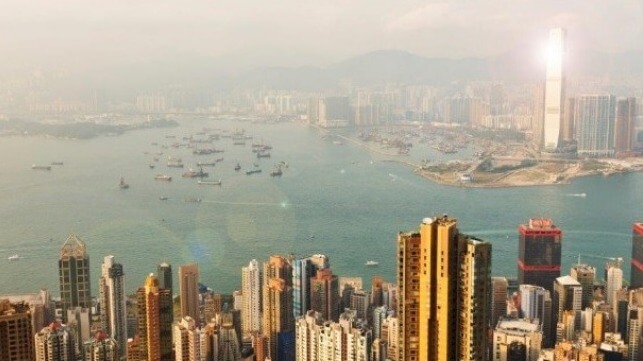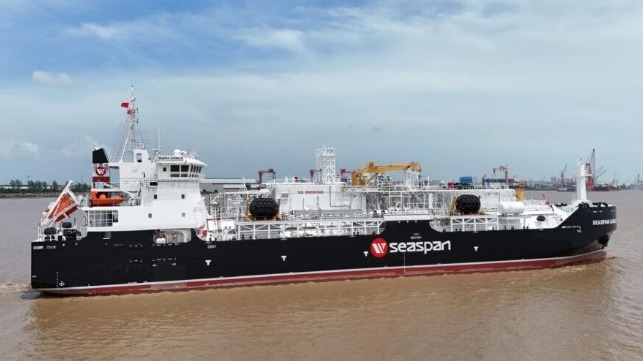Hong Kong Maps Action Plan on Green Maritime Fuel Bunkering

The Government of Hong Kong hosted a presentation on Friday, November 15 to detail its action plan to promote the development of Hong Kong into a high-quality green maritime fuel bunkering center. As one of the busiest ports in Asia, the government looks to catch up and remain competitive with regional rivals such as Singapore while incorporating the central government’s decarbonization plans and anticipated industry demand.
Hong Kong’s Chief Executive announced in the 2023 Policy Address the goal to develop Hong Kong into a green maritime fuel bunkering center. In addition, China’s Five-Year Plan calls for measures to promote the development of green ports and enhance the promotion and application of clean maritime fuels.
The Transport and Logistics Bureau (TLB), in collaboration with the Environment and Ecology Bureau, reports it has conducted a feasibility study and proceeded to formulate the Action Plan released on Friday by taking into account international experiences and the current market developments, as well as in consultation with the Hong Kong Maritime and Port Board (HKMPB) and various organizations and players in the industry.
The Action Plan also reflects the expectation that the International Maritime Organization will promulgate a maritime fuel standard and launch a global maritime carbon pricing mechanism by 2027 driving the need to develop green bunkering capabilities.
Among the goals set for Hong Kong is reducing carbon emissions for Hong Kong registered vessels by at least 11 percent compared to 2019 levels. They are also seeking to ensure that 55 percent of the diesel-fueled vessels in the government fleet switch to using green fuels by 2026. Carbon emissions from the Kwai Tsing Container Terminal are targeted to fall by at least 30 percent compared to 2021 levels.
Among the goals of the Action Plan to to ensure that at least seven percent of Hong Kong-registered ships take up green maritime fuels by 2030. The government projects that the bunkering service will involve over 200,000 tonnes of green maritime fuels by 2030, with at least 60 bunkering operations.
"This Action Plan fully reflects the Hong Kong Special Administrative Region Government's determination to develop green maritime fuel bunkering, and provides clear and definite directions and action targets for Hong Kong to keep pace with the international trends of green shipping,” said Lam Sai-hung, Hong Kong’s Secretary for Transport and Logistics.
The plan sets out five strategies and 10 actions to develop the supply and infrastructure for green maritime fuels. The government reports it has identified a land parcel near the port for green maritime fuel storage and expects to invite expressions of interest from the industry next year in developing the designated site. It will also facilitate the first LNG ship-to-ship bunkering demonstration by the industry within the first half of 2025. It also plans to establish a Green Maritime Fuel Bunkering Incentive Scheme to encourage enterprises to start green maritime fuel bunkering businesses in Hong Kong.
To build the supply chain for green maritime fuels, the government will also seek to facilitate offtake agreements between the green fuel bunkering supplies from the mainland and shipping companies.
By early next year, the government expects to release a comprehensive Code of Practice both for LNG and methanol bunkering. These steps are viewed as a key part of the strategy to build Hong Kong’s role in the future green bunkering marketplace.
Vancouver Accredits Seaspan Energy for First LNG Ship-to-Ship Bunkering

The Port of Vancouver and Seaspan Energy took a key step forward to launching the first ship-to-ship LNG bunkering operation for a wide range of vessels calling at the port. The company went through an extensive multi-year assessment process conducted by the Vancouver Fraser Port Authority in collaboration with other Canadian authorities to ensure the safety of the new operation.
Seaspan Energy is working toward launching its LNG bunkering operation along the West Coast of North America. Harly Penner, Senior Vice President of Seaspan Energy called the accreditation a “meaningful step,” towards the start-up of the Vancouver-based LNG bunkering hub.
The first two of three newly built 7600 cbm LNG bunkering vessels are due for delivery in the near future with a third scheduled for 2025. The LNG bunkering vessels are being built by CIMC Sinopacific Offshore & Engineering after Seaspan Energy worked closely with the Canadian-based team at VARD Marine to incorporate emerging technologies resulting in a decrease in emissions and underwater noise.
Each of the vessels will be approximately 113 meters (approximately 370 feet) in length with a design speed of 13 knots. Seaspan reports the design is focused on safe, efficient, and economical refueling of multiple ship types with an ability to transfer to and from a wide range of terminals. The vessels will be engaged in ship-to-ship LNG transfer along with coastal and short-sea shipping cargo operations.

Three vessels due for delivery in 2024 and 2025 will provide the new ship-to-ship bunkering operation (Seaspan Energy)
The first of the vessels, Seaspan Garibaldi was launched in January 2024. It was followed by the launching of Seaspan Lions in April and Seaspan Baker in July.
The Port of Vancouver highlights that it is a key step in its efforts to meet industry demands and proceed with sustainability programs. They expect to be able to provide bunkering operations to a wide range of vessels including Ro-Ro vehicle carriers, tankers, containerships, and cruise ships expanding the role of the port in the West Coast trade.
The safety assessment program incorporated international best practices, assessed operational procedures, and produced a risk assessment. Vancouver approved designated locations for LNG bunkering operations within the port area.
The port authority is also requiring Seaspan Energy to renew its license annually to ensure it continues to meet the highest LNG bunkering safety standards and procedures.
No comments:
Post a Comment